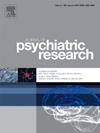Psychometric properties of the Federal Unit Scale for general psychopathology screening without iatrogenic effects
IF 3.7
2区 医学
Q1 PSYCHIATRY
引用次数: 0
Abstract
Mental health assessment tools play a crucial role in clinical practice, yet many existing scales risk exacerbating the conditions they aim to measure. This study introduces the Federal Unit Scale (FUS), a novel 5-item scale designed to assess a broad range of affect and traits capturing distress tolerance while minimizing potentially triggering language. The FUS was developed with a focus on combat veterans, frontline workers, and first responders. We examined its psychometric properties using two samples: a clinical sample (N = 1798) and a crowdsourced sample (N = 10,000). Psychometric analyses revealed strong internal consistency (α = 0.84), essential unidimensionality (ωh = 0.75), and excellent measurement precision across a broad trait range (−2.5 to 2.0 SD). The FUS demonstrated robust convergent validity with established measures including the PHQ-9, GAD-7, and PCL-5 (r = 0.59–0.66), though correlation with the Columbia-Suicide Severity Rating Scale was modest (r = 0.22). Receiver operating characteristic analyses showed good discrimination of clinical severity based on established measures (AUC = 0.77–0.81) and excellent discrimination between treatment-responsive and help-seeking individuals (AUC = 0.92). The FUS achieves these psychometric properties while avoiding symptom-focused language that could trigger distress, making it particularly suitable for vulnerable populations such as combat veterans, first responders, and trauma survivors. Future research should explore its long-term predictive validity, cross-cultural applicability, and effectiveness in various clinical settings.
求助全文
约1分钟内获得全文
求助全文
来源期刊

Journal of psychiatric research
医学-精神病学
CiteScore
7.30
自引率
2.10%
发文量
622
审稿时长
130 days
期刊介绍:
Founded in 1961 to report on the latest work in psychiatry and cognate disciplines, the Journal of Psychiatric Research is dedicated to innovative and timely studies of four important areas of research:
(1) clinical studies of all disciplines relating to psychiatric illness, as well as normal human behaviour, including biochemical, physiological, genetic, environmental, social, psychological and epidemiological factors;
(2) basic studies pertaining to psychiatry in such fields as neuropsychopharmacology, neuroendocrinology, electrophysiology, genetics, experimental psychology and epidemiology;
(3) the growing application of clinical laboratory techniques in psychiatry, including imagery and spectroscopy of the brain, molecular biology and computer sciences;
 求助内容:
求助内容: 应助结果提醒方式:
应助结果提醒方式:


